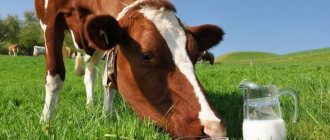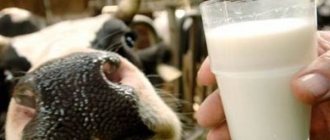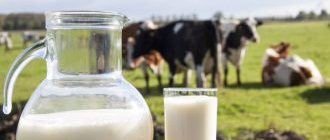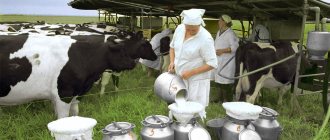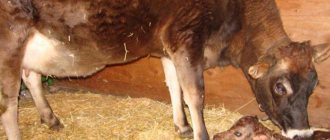Causes of odor
The unpleasant odor mainly comes from manure and other non-milk secretions. This cannot be considered the norm.
Diseases
One of the most common causes of bad odor and taste in milk is animal disease. That is why, having received poor milk yield, it is necessary first of all to check the health of the cow. Since milk is taken from a dairy cow every day, it can be an excellent marker of her well-being.
What diseases do cows suffer from?
- Mastitis . A common disease that occurs mainly during calving problems and other similar situations. Purulent inflammation of the udder cannot have a positive effect on the quality of milk and such a product should not be consumed.
- Udder furunculosis . A disease with similar symptoms that greatly reduces both the quantity and quality of milk.
- Agalactia . Lactation disturbance (milk insufficiency). It may cause spoiled milk odor at those stages where milk yield has not yet completely disappeared.
These are just the main examples that farmers encounter most often. There are many other, no less dangerous diseases. You should contact your veterinarian at the first sign of a bad milk odor.
Hygiene
The simplest failure to comply with hygiene rules can spoil the milk. Most often, cow owners or their clients complain about the smell of manure from milk. Sometimes it is so strong that milk that is good by all other factors has to be thrown away. The solution to this problem is simple. It is necessary to keep cows clean and monitor their diet.
The main causes of unpleasant odors are dirty pens (it is advisable to clean them daily) and dirty animals. Cows cannot clean themselves and get dirty very quickly, especially in the area of the udder, which is soft and not protected by hair. Take this into account and wash the udder before each milking.
What to pay attention to:
- Do not allow dirt near milk. Since cows may lie in a stall, the udder and teats themselves become contaminated with waste. Be sure to check their condition before expressing.
- Sometimes animals can interfere with milking. For example, a tail can get into a container of milk and this is enough to spoil a particular milk yield.
It is advisable to devote time to animal hygiene at least once a day.
A real embodiment of a farmer's dream - a Jersey cow
To know
Where to start breeding bulls for meat as a business?
Read
Nutrition
The nutrition of cows greatly influences what the milk will be like . As a rule, what a cow eats the day before milking directly affects the taste.
What is contraindicated:
- Low-quality, rotten food: hay, musty grass, rotten vegetables and fruits.
- Medicines in food. If the cow needs to be treated, then the milk milked during this period cannot be drunk.
For tasty milk, the diet of animals must be complete and consist of fresh, high-quality products. The better the food, the less often you can find such a taste in the milk. Also, the quality of the feed determines the likelihood of diseases that can change the taste of the milk.
If you are not sure what exactly spoils milk yield, analyze the diet and use the elimination method to get rid of the unwanted product.
Causes of quickly sour milk
The shelf life of dairy products without the use of processing agents is an important factor. To solve this problem, certain conditions must be met; failure to comply will affect the rate of souring.
- Bacteria thrive in warm conditions. The optimal temperature for the development of microorganisms is 30-40 degrees. Therefore, the product should be stored at a temperature close to 4 degrees Celsius in a refrigerator or special room.
- Milk smells like a cow when there is product from several individuals in one container; this also speeds up the souring process.
- Violations of sanitary standards, which may include dirty or wet dishes during milking or straining, milking with dirty hands, or poorly washed udders.
- Some herbs during flowering affect the composition of the milk drink, increasing acidity.
- Some diseases affecting the microflora of the animal's body.
Violations of sanitary standards
How to get rid of odor
Before you start getting rid of the smell, it is advisable to find out its cause. That is, the first milk yield with this sign should not be drunk in any case. Cows have diseases in which it is better for a person to refrain from drinking milk.
You should be especially careful about the smell of acetone. Its presence is a much more serious signal of danger than the usual “smell of a cow.” You can't drink this kind of milk at all.
Step-by-step instructions for getting rid of odor:
- Pour the milk into a clean container (not the one used during milking) and better assess the degree of unpleasant odor.
- Check the milk for other factors: even consistency and color (white or beige), absence of foreign inclusions. If you notice traces of blood or pus in the milk, throw it away and do not try to make it edible.
- If everything is ok, try boiling the liquid. To do this, you need to bring the milk to a boil once, remove the film and check the taste/smell. If it doesn’t help and you can still smell it, repeat the procedure.
- As an additional method of getting rid of the smell, you can try boiling milk with salt. The tricky part is not to overdo it.
The success rate of the procedure is not one hundred percent, but milk with a weak or moderate odor can most often be saved.
One of the most sought after and popular breeds of cows in the world is the Holstein dairy cow.
Look
The most common breed of cows in Russia is the “Black Motley”
Read
Properties and aroma of the product
Cow's milk contains protein. It is very well absorbed by animals and humans. A liter of product is nutritionally equivalent to half a kilogram of meat. This volume contains the daily dose of calcium.
Lactose or natural sugar is an integral part of milk. Only because of her can his intolerance be. In this case, it is harmful to use it.
However, among the factors of “intolerance” there may be not only objective reasons, such as an allergy to milk sugar. But also subjective reasons. Many people cannot stand the taste and smell of milk. It is worth understanding what affects the main indicators of this product in a cow:
- appearance;
- degree of thickness;
- color characteristics;
- aroma;
- mouthfeel.
According to the developed standards, milk should not contain sediment, flakes, foreign tastes and odors. A properly prepared or freshly mined product is a homogeneous liquid. Color can vary from white to soft beige.
The fat content of milk forms special balls. They create a white tint and impermeability of the product. Why does a healthy, unobtrusive beige color appear? It is associated with carotene dissolved in fat. Milk has a sweet and salty taste, which is given to it by lactose, fatty acids, chlorides, and proteins. Fat gives milk a specific, delicate taste.
It is believed that the higher the fat content, the more pleasant it is to drink.
All of these properties of this beloved delicacy may change. For this reason, even from one cow, depending on the season, feeding and many other factors, livestock farmers receive different milk.
More on the topic: Is it possible to drink milk if a cow has leukemia?
Useful tips
There are a few simple rules that practically guarantee excellent, fresh and pleasant-smelling milk after every milking:
- Daily cleaning of stalls. This is difficult to do on your own when there are many animals, but it is easy to provide for one or two cows. The bedding or dirt floor in the room where animals are kept should not be allowed to be covered in manure or dirt of other origins. Dryness is necessary, which means the absence of impurities.
- After milking, it is necessary not only to strain the milk, but also to cool it. This way, the chances of preserving it in the required quality are much greater, because the cold prevents the growth of bacteria.
- It's not just the udder area that matters. Clean the fur in all adjacent areas, and trim off any accumulated manure if necessary.
If you find an error, please select a piece of text and press Ctrl+Enter.
Types of milk based on production methods
Considering the types of modern production, several types of milk can be distinguished.
- Whole is a completely natural product that has not been subjected to any processing. Such cow's milk, the composition of which has not been changed by any influence, can only be purchased from residents of agricultural areas who have cows on their farms, or directly from dairy farms immediately after milking.
- Pasteurized is milk that has been heated. Pasteurization can be long-term (heating milk to a temperature of 63-65 degrees for 30 minutes), short (milk is heated to 85-90 degrees in one minute) and instantaneous (in a few seconds the milk temperature reaches 98 degrees).
- Ultra-pasteurized - milk obtained by heating whole milk for 2-3 seconds to 150 degrees.
- Sterilization - milk is kept for about 20-30 minutes at temperatures above 100 degrees.
Although the pasteurization method allows the product to be stored for quite a long time, up to 30 days, the composition and properties of cow's milk, according to experts, change. This is especially true for the ultra-pasteurization method, which leaves virtually no beneficial substances in the milk. Sterilized milk has an even longer shelf life, but also loses many nutrients. Despite this, sterilized milk, due to its long shelf life, is now increasingly preferred by consumers. In addition, it is more resistant to transportation than pasteurized. That is why it is an ideal product to supply residents of remote regions.
How to increase milk yield?
High milk productivity is the goal of any farmer, and if the issue of choosing a breed is relevant only at the first stages of the path to animal husbandry, then increasing the milk yield of an existing livestock is a problem that can be solved in a fairly short time.
The quality of nutrition is not even worth mentioning, this is a fundamental dogma, but there are other factors, sometimes completely unexpected.
- Proper milking, especially when milking by machine. Before starting, you need to massage the udder for about a minute, this will relax the animal and increase the flow of milk.
- A cow is a delicate animal, so it is better to avoid loud noises and rough handling when milking.
- The seasonal decrease in milk yield is also associated with shortening daylight hours.
- A cow gives little milk only if the conditions in which she is not conducive to high milk yield, so try simply changing the stall or changing the diet of additives and premixes.
The cow gives little milk
Read also: Do mice eat polyurethane foam?
Cow's milk: taste and color
How to distinguish good milk from bad?
1. Country cow's milk should be opaque, rich white, sometimes even “cream” in color, because its fat content is quite high - from 3 to 6%.
If the milk you bought is thin, watery, and “bluish” in color, it means it was diluted with water. Of course, it’s not worth buying such milk next time. You can determine whether milk has been diluted or not: drop it into a glass of clean water: a drop of good milk will gently fall to the bottom of the glass and will not dissolve immediately.
2. In good milk, after some time (after 5-8 hours), thick, fatty cream will form on top. A housewife who sells milk that has been standing for a while, and not just milked, can either stir them back into the milk or remove them. In the first case, after some time the cream will float to the surface again in an even dense layer, in the second - there will be very little or none at all.
3. Good milk should smell like fresh milk. It cannot have a sour smell. And most importantly, milk should not smell like manure. The only exception would be freshly milked milk: it sometimes has a slight, barely perceptible smell of a barn, which, however, disappears very quickly.
4. Good milk should sour - turn into yogurt. This is absolutely normal. The lactic acid bacteria contained in real milk are responsible for this process.
If you want to speed up the souring process, put the milk in a warm place for four hours, after putting a crust of black bread in it or stirring a spoonful of sour cream, kefir or natural yogurt into it.
If, on the contrary, you want the milk not to sour longer, store it in the refrigerator. Spring and summer milk does not sour during the day, autumn milk (from about October) is stored longer - it does not spoil for three to four days.
Boiled milk can be stored in a cold place for a whole week.


